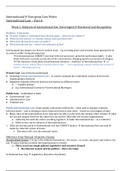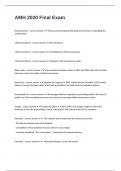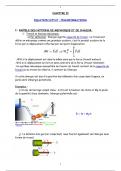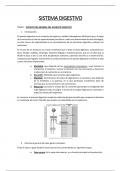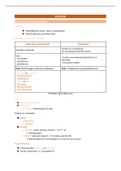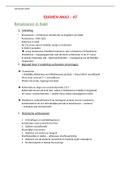International & European Law Notes
International Law – Part A
Week 1: Subjects of international law, Sovereignty & Statehood and Recognition
Klabbers: 4 Questions;
To what entities or individuals does the law apply – what are the subjects?
What are the sources: i.e. treaties, statues and customary law?
What does the law do in case of conflict?
What does the law say – what is the substance of law?
International law shapes our lives in various ways – e.g. securing peace and security, basic guarantees in
an armed conflict (humanitarian law)
International law DOESN'T just deal with war and peace, genocide and human rights – it also
deals with rules on trade, protection of the environment, shipping and the protection of refugees
The existence of any kind of international relations = existence of International law ubi
societas, ibi jus “where there is society there is law” – rule regulating contacts within the society of
states = International Law
Private Law: Law between individuals
Including Private International Law – in essence national law (individual conduct between the
transboundary barriers)
Regulates relations between persons and entities in different states
o = “Conflict of laws”
o E.g. International Contracts & International Marriages.
Public Law = Individual vs State
Constitutional Law
Administrative Law
Criminal Law
Public International Law: Deals mainly with states collectively – often said to regulate relations
between states – and is relating to their relations between each other – based on sovereignty of state
Many rules of international law don't only have an effect on the state but include other entities rules
are not just shaped between the states but can involve IGOs and civil society organisations
o Authority lies with the states (working together) to make International Law – as a collective
o Other actors can be subjects of International Law
1. IGOs can become party to International Law but CANNOT make it International law can only be
made by collective action of states
Execution of IL is in the national courts
Difference From National (Domestic) System
Decentralised System: It is up to the subjects themselves – the states – to create, interpret and enforce the
law many systems in which International law is created
o There is not one single judicial, legislative and executive branch
No coherent system of trias politica – there are many
Vs National Law: Sop Legislative, Executive & Judiciary
, - Vertical Relationship: people bound by state
- State is bound by rules
Based on inter-state relations (states working together)
Public International law is NOT Private International law and NOT EU law
o EU law is from the EU members and only applies to member states
1. EU law has acquired some supranational powers
Public International law van best be described as a tree:
Trunk: Components which are foundational and cross-cutting
o Subjects
o Sources of International
o Law of treaties
o International vs Domestic Law
o Jurisdiction and Immunities
o State Responsibility
Branches:
o Law of the Sea
o International trade law
o International Criminal law
o Human Rights law
These often become intertwined
History:
15th & 16th Century
Partly originates from Europe in the late middle ages – relations between merchants (traders &
diplomats) and maritime law
Much of Europe tended to be organised in large Empires = Roman Empire to reign of Charlemagne
thought of empires as single entities = law conceptualised as internal didn't think beyond the
boundries
International Law was NOT invented by a single person but grew from the interactions of states and
commentaries of observers.
Two fathers of International Law
Francisco de Vitoria (around 1500)
1. School of Salamanca (scholar in natural law) – law isnt made but found in nature
2. Instrumental in creating a moral justification for the creation of a legal system which would spread
global capitalism (Common morality)
3. Spanish explores and native Indian populations (natives were part of the human race and were
governed by natural law)
4. Natural law is the way in which society is and the way things are
Similar to human rights law and humanitarian law
Natural vs Positive law:
Natural law: laws are derived from god and they are a fact: source nature or god – there is a higher power that dictates this
law
,Hugo Grotius
1. Builds bridge between naturalism and positivism
Positive law: law is the way in which it is written down and is man made
2. MODERN THOUGHT: There should be a good mix between the two theories
- Law of war and Peace
- Mare Liberum – treaty on the law of the sea – common prop of human kind + UNCLOS
3. Stated that natural law would exist even if there was no god
17th and 18th Century = Foundations of Modern International Law
Development of Modern Legal system
17th century: Peace of Westphalia (1648)
Before 1648, the idea was we had two kinds of authorities:
a) A secular authority (Emperor of the holy roman empire) was the continuation of the roman empire,
that authority was limited couldn't really decide things in other countries, but it was there.
b) The second authority was the spiritual authority of the pope, the leader of the Roman Catholic
Church, undermined by the reformation.
HOWEVER, Peace concluded the end of the 30 & 40 years’ war between catholic and protestants =
victory to secular authority
o (creation of the feudal system & beginning of modern concept of sovreignty)
o Europe was agreed to be divide into an number of territorial units – each could decide
which religion to adopt = SOVREIGN STATES Modern states system “suprema potestas”
o Treaties of Westphalia were signed – ratification of Treaty of Munster
1) Sovereignty of States was implemented – states highest authority and do not derive their power from
anywhere else
State was dominant because it had the authority to live up to its commitments – by
controlling territory.
1655: Grotius Publication: On the Law of War and Peace
o Was an influential piece which shaped international law in order to uphold the freedom of the
seas
o This innovation and notion that all people have the right to trade = trading routes such as the sea
should be free
o It addressed not only common international law topics but matters such as the binding force of
treaties – considered one of the first to set binding international obligations.
Developments in Natural Law vs Positive Law
o Natural Law: suggests that law is not made but it is found – existing in nature “ordained by God”
– it can be recognised through proper analysis or by those of the correct faith
o Positivism: Law is not given = man-made – it is whatever the states decide or agree it is
Prior to the 17th centenary and including it nations ad citizens were subject to natural law
based on religious morals and based on the belief in God – changed as arguments about law
started being based on reason and rational
Per Hugo Grotius, “these rules would still exist even if God were not to exist” = movement from
religion to rationality and natural positivism
Codification – rules laid down in case law
, → Enlightenment ←
Colonialism: emergence of early modern international law can be understood in light of the struggle
between European powers
European countries started to explore the world with their superior techniques and resources and
started dominating the rest of the world- certain rules were considered to be in place in order to
regulate relations with “natives”
Among these rules was the rule that territories found overseas were to be regarded as not having
been subject to sovereignty – as territory belonging to no one (terra nullius) meaning that they could
be “taken” by European powers
o Congress of Berlin (1885): this was the start of the colonialization of Africa
o Codification was slowly introduced, starting with France codifying their rules into a Civil and
criminal code and other European countries followed suit
Code Civil other EU countries followed
o Congress of Vienna (1814): this is where the future of the organisation of Europe was
decided with the creation of the “great powers” (Great Britain, Russia, Germany, Spain &
France)
These “great powers” created conferences and would deal and negotiate on a solution
for certain issues
o International law was also played an important role when it came to slavery – allowing it and
then later creating the prohibition of slavery
19th Century: L.F.L Oppenheim believed that because “law of the nations” was based on common
consent of the state rather than individuals = that states were the sole subjects of international law
o States are the subject of International Law (ONLY ONES)
o States co-existed
o Sovereign equality = non intervention
o State Sovereignty – supreme power/authority
o No supranationalism in comparison to EU law
o Legal positivism: was based on the consent of the states – only true source of international
law is state will
Consent = source of legitimacy of IL
20th Century: Increasing collaboration and complexity of International Law
o Goals are realised which require collaboration
o Economic dependency due to more trade
o Mobility of people across the world (Individuals and organisations)
Increased threats – (internal) armed conflict, terrorism, environmental threats and
health threats
o States in flux: states when from coexistence need for cooperation = increased cooperation
1. Establishment of positive agreements (btw states)
IOs and NGOs – increasingly important
Post WW1 LoN = failure due to WW2
International Law – Part A
Week 1: Subjects of international law, Sovereignty & Statehood and Recognition
Klabbers: 4 Questions;
To what entities or individuals does the law apply – what are the subjects?
What are the sources: i.e. treaties, statues and customary law?
What does the law do in case of conflict?
What does the law say – what is the substance of law?
International law shapes our lives in various ways – e.g. securing peace and security, basic guarantees in
an armed conflict (humanitarian law)
International law DOESN'T just deal with war and peace, genocide and human rights – it also
deals with rules on trade, protection of the environment, shipping and the protection of refugees
The existence of any kind of international relations = existence of International law ubi
societas, ibi jus “where there is society there is law” – rule regulating contacts within the society of
states = International Law
Private Law: Law between individuals
Including Private International Law – in essence national law (individual conduct between the
transboundary barriers)
Regulates relations between persons and entities in different states
o = “Conflict of laws”
o E.g. International Contracts & International Marriages.
Public Law = Individual vs State
Constitutional Law
Administrative Law
Criminal Law
Public International Law: Deals mainly with states collectively – often said to regulate relations
between states – and is relating to their relations between each other – based on sovereignty of state
Many rules of international law don't only have an effect on the state but include other entities rules
are not just shaped between the states but can involve IGOs and civil society organisations
o Authority lies with the states (working together) to make International Law – as a collective
o Other actors can be subjects of International Law
1. IGOs can become party to International Law but CANNOT make it International law can only be
made by collective action of states
Execution of IL is in the national courts
Difference From National (Domestic) System
Decentralised System: It is up to the subjects themselves – the states – to create, interpret and enforce the
law many systems in which International law is created
o There is not one single judicial, legislative and executive branch
No coherent system of trias politica – there are many
Vs National Law: Sop Legislative, Executive & Judiciary
, - Vertical Relationship: people bound by state
- State is bound by rules
Based on inter-state relations (states working together)
Public International law is NOT Private International law and NOT EU law
o EU law is from the EU members and only applies to member states
1. EU law has acquired some supranational powers
Public International law van best be described as a tree:
Trunk: Components which are foundational and cross-cutting
o Subjects
o Sources of International
o Law of treaties
o International vs Domestic Law
o Jurisdiction and Immunities
o State Responsibility
Branches:
o Law of the Sea
o International trade law
o International Criminal law
o Human Rights law
These often become intertwined
History:
15th & 16th Century
Partly originates from Europe in the late middle ages – relations between merchants (traders &
diplomats) and maritime law
Much of Europe tended to be organised in large Empires = Roman Empire to reign of Charlemagne
thought of empires as single entities = law conceptualised as internal didn't think beyond the
boundries
International Law was NOT invented by a single person but grew from the interactions of states and
commentaries of observers.
Two fathers of International Law
Francisco de Vitoria (around 1500)
1. School of Salamanca (scholar in natural law) – law isnt made but found in nature
2. Instrumental in creating a moral justification for the creation of a legal system which would spread
global capitalism (Common morality)
3. Spanish explores and native Indian populations (natives were part of the human race and were
governed by natural law)
4. Natural law is the way in which society is and the way things are
Similar to human rights law and humanitarian law
Natural vs Positive law:
Natural law: laws are derived from god and they are a fact: source nature or god – there is a higher power that dictates this
law
,Hugo Grotius
1. Builds bridge between naturalism and positivism
Positive law: law is the way in which it is written down and is man made
2. MODERN THOUGHT: There should be a good mix between the two theories
- Law of war and Peace
- Mare Liberum – treaty on the law of the sea – common prop of human kind + UNCLOS
3. Stated that natural law would exist even if there was no god
17th and 18th Century = Foundations of Modern International Law
Development of Modern Legal system
17th century: Peace of Westphalia (1648)
Before 1648, the idea was we had two kinds of authorities:
a) A secular authority (Emperor of the holy roman empire) was the continuation of the roman empire,
that authority was limited couldn't really decide things in other countries, but it was there.
b) The second authority was the spiritual authority of the pope, the leader of the Roman Catholic
Church, undermined by the reformation.
HOWEVER, Peace concluded the end of the 30 & 40 years’ war between catholic and protestants =
victory to secular authority
o (creation of the feudal system & beginning of modern concept of sovreignty)
o Europe was agreed to be divide into an number of territorial units – each could decide
which religion to adopt = SOVREIGN STATES Modern states system “suprema potestas”
o Treaties of Westphalia were signed – ratification of Treaty of Munster
1) Sovereignty of States was implemented – states highest authority and do not derive their power from
anywhere else
State was dominant because it had the authority to live up to its commitments – by
controlling territory.
1655: Grotius Publication: On the Law of War and Peace
o Was an influential piece which shaped international law in order to uphold the freedom of the
seas
o This innovation and notion that all people have the right to trade = trading routes such as the sea
should be free
o It addressed not only common international law topics but matters such as the binding force of
treaties – considered one of the first to set binding international obligations.
Developments in Natural Law vs Positive Law
o Natural Law: suggests that law is not made but it is found – existing in nature “ordained by God”
– it can be recognised through proper analysis or by those of the correct faith
o Positivism: Law is not given = man-made – it is whatever the states decide or agree it is
Prior to the 17th centenary and including it nations ad citizens were subject to natural law
based on religious morals and based on the belief in God – changed as arguments about law
started being based on reason and rational
Per Hugo Grotius, “these rules would still exist even if God were not to exist” = movement from
religion to rationality and natural positivism
Codification – rules laid down in case law
, → Enlightenment ←
Colonialism: emergence of early modern international law can be understood in light of the struggle
between European powers
European countries started to explore the world with their superior techniques and resources and
started dominating the rest of the world- certain rules were considered to be in place in order to
regulate relations with “natives”
Among these rules was the rule that territories found overseas were to be regarded as not having
been subject to sovereignty – as territory belonging to no one (terra nullius) meaning that they could
be “taken” by European powers
o Congress of Berlin (1885): this was the start of the colonialization of Africa
o Codification was slowly introduced, starting with France codifying their rules into a Civil and
criminal code and other European countries followed suit
Code Civil other EU countries followed
o Congress of Vienna (1814): this is where the future of the organisation of Europe was
decided with the creation of the “great powers” (Great Britain, Russia, Germany, Spain &
France)
These “great powers” created conferences and would deal and negotiate on a solution
for certain issues
o International law was also played an important role when it came to slavery – allowing it and
then later creating the prohibition of slavery
19th Century: L.F.L Oppenheim believed that because “law of the nations” was based on common
consent of the state rather than individuals = that states were the sole subjects of international law
o States are the subject of International Law (ONLY ONES)
o States co-existed
o Sovereign equality = non intervention
o State Sovereignty – supreme power/authority
o No supranationalism in comparison to EU law
o Legal positivism: was based on the consent of the states – only true source of international
law is state will
Consent = source of legitimacy of IL
20th Century: Increasing collaboration and complexity of International Law
o Goals are realised which require collaboration
o Economic dependency due to more trade
o Mobility of people across the world (Individuals and organisations)
Increased threats – (internal) armed conflict, terrorism, environmental threats and
health threats
o States in flux: states when from coexistence need for cooperation = increased cooperation
1. Establishment of positive agreements (btw states)
IOs and NGOs – increasingly important
Post WW1 LoN = failure due to WW2


